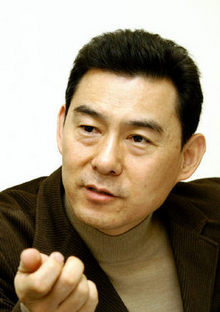Posted on : Nov.15,2006 14:33 KST
Modified on : Nov.16,2006 13:54 KST
Ha Jong Kang, Manager of the Hanul Labor Institute
The Korean Confederation of Trade Unions (KCTU, Minju Nochong) holds two major large public assemblies each year, one in May and the other in November. Tens of thousands of workers gather like clouds, so many in fact that labor activists from other countries come on "field trips" to observe it all, because in most places it is hard to see so many workers moving in perfect, passionate unison. Most foreigners who get to see this come to have a sense of awe for the Korean labor movement, but there are others who are somewhat critical regarding the massive gathering. "Is the atmosphere of the Korean labor movement really this totalitarian?" they ask. "Doesn’t it look more like something pre-modern, or something that belongs in Hitler’s era?"
There was one foreign activist who, observing tens of thousands of workers cheer with wild enthusiasm upon seeing the head of the KCTU and other labor leaders rise to the podium, said he thought things looked a little behind the times. Another foreign activist, someone quite familiar with the Korean labor movement, responded, "Do you know the spirit of Chun Tae-il? Do you know of the history of the labor movement in Korea, a tradition that has maintained itself only because many have died along the way? You should not speak like that without knowing these things."
In no other country has there been the same kind of painful labor history, where the tradition of the movement has been carried on through the deaths of so many workers who take their own lives as yeolsa (martyr, patriot). Let me ask: is this merely because Korean laborers "thoughtlessly" kill themselves in the name of the cause?
I was the officiator at one worker’s wedding ceremony a few days ago. This person works at a government-funded agency; the union there is on its 271st day of a strike. During a recent National Assembly audit, a lot of furious accusations were leveled about a government official repeatedly telephoning the head of this government-funded agency and ordering workers who had blown the whistle on corruption there to be fired. Other accusations included illegal suppression of labor rights, the inappropriate use of the agency’s credit cards, assault and sexually abusive language directed at female workers, the squandering of legal funds, and that on occasion the agency had actually encouraged strikes for strategic reasons.
A union official I met right before the wedding started begged that I keep from mentioning the fact that a strike was going on because the bride and groom had kept their parents unaware of what was going on. Is the strike unjustified, to the point that you would want to keep it a secret from your parents for 271 days?
Recently some of the striking train car service crew from KTX showed up at a college lecture. At the time they had already been on strike for a total of 256 days. One student asked them why they keep fighting and do not just look for new jobs.
"It hurts the most when we get that question," said one of the young ladies. "That would be a solution for the individual who made that choice. But that would mean that those who follow in our footsteps, the eight million irregular workers across Korea, and our children who have yet to be born will eventually have to experience the same misfortune."
When the class was over, another woman from KTX spoke. "We have tried everything except taking our own lives. I have come to understand how yeolsa Chun Tae-il must have felt that he had no choice but to choose death."
November 13 is upon us again, the date when, 36 years ago, Chun Tae-il immolated himself during a labor demonstration outside of a Seoul market, clutching a copy of the Korean labor law and shouting, "We are not machines!" Let me ask of those who live in the structure of oppression created by state power and capital but cannot appreciate the situation: Do you know the spirit of Chun Tae-il? Do you know the painful history of the Korean labor movement, which became what it is today because of the deaths of those before?

